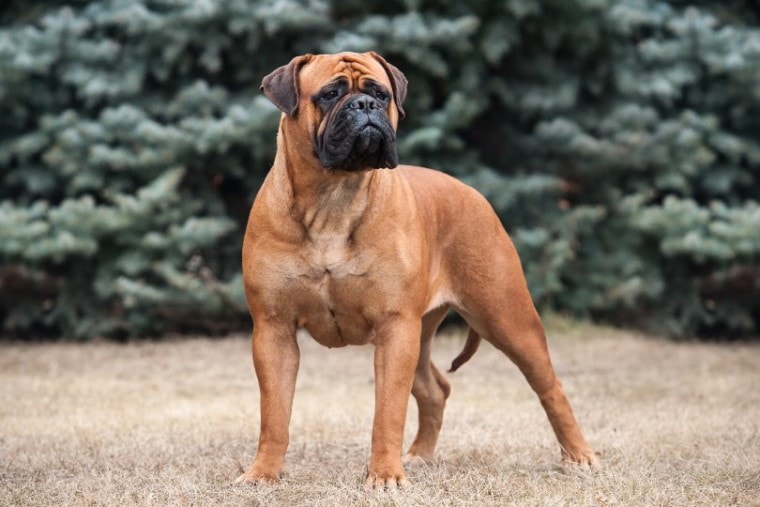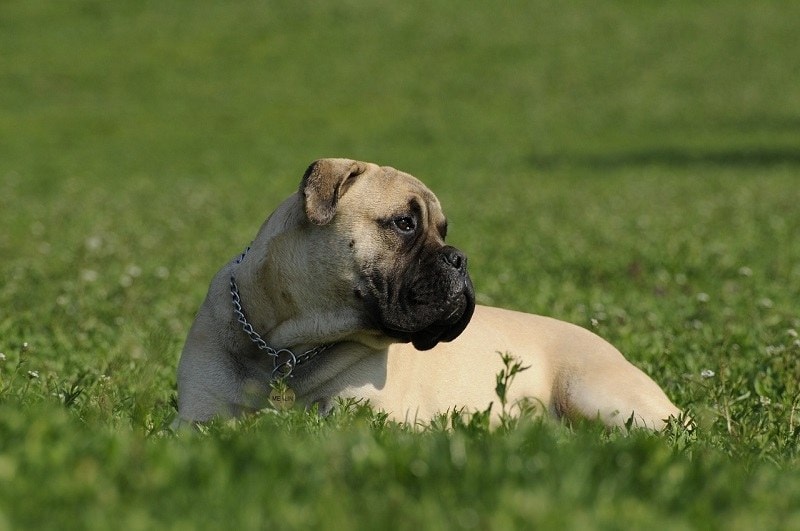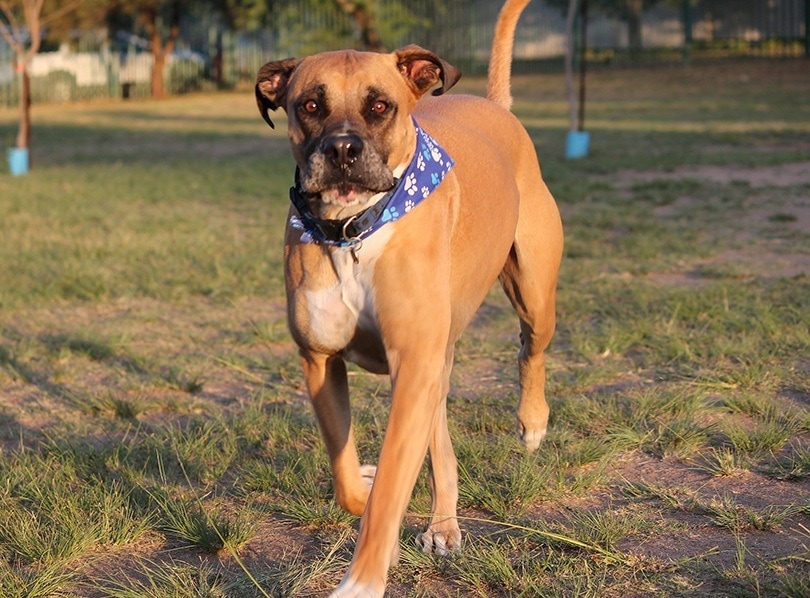
Click Below to Skip Ahead
You’d recognize a Bullmastiff by its wide, wrinkled head and short, squared jaw. Their black nose and hazel eyes stand out across their red-colored fur, and their large, powerful bodies look awfully intimidating. Bullmastiffs give off an intimidating first impression, but they’re really gentle giants that are highly affectionate towards their family members.
Breed Overview
Height:
25 – 27 inches
Weight:
100 – 130 pounds
Lifespan:
7 – 9 years
Colors:
Red, brindle, fawn
Suitable for:
Families looking for a loyal guardian and companion for high-energy activities
Temperament:
Loyal, brave, easy-going, affectionate
Bullmastiffs are fearless, muscular dogs with even larger cousins, the Mastiff. Their history directly correlates to being guard dogs for the English aristocracy’s country estates and game preserves, so you know they’ll always have your back and keep an eye out for you. If you’ve considered bringing a Bullmastiff into your life, browse through all their breed traits to determine if they’d make a good fit in your home.
Bullmastiff Characteristics
Bullmastiff Puppies

There is a massive myth that large dogs require the most exercise. Just because they have big bodies doesn’t mean they have to be running every day. As long as they don’t live a completely sedentary lifestyle, a Bullmastiff remains relatively healthy with moderate exercise. This dog breed is usually healthier with a little more activity than average, but they are adaptable, and going for a couple of walks a day will suffice.
Bullmastiffs have a moderate intelligence level that makes them fairly easy to train. They tend to be slightly suspicious of humans who aren’t in their immediate family, so socializing them early is ideal. However, Bullmastiffs are overall very friendly and don’t have any significant issues around humans and other pets.
As it goes with large breeds, Bullmastiffs don’t have the most extraordinary lifespan or health record. Most Bullmastiffs live for around 9 years, and there is an expansive list of genetic health threats that are responsible. If you’re willing to put those aside, Bullmastiffs make excellent companions, and both of you will quickly grow an attachment to one another.

Temperament & Intelligence of the Bullmastiff
The history of a Bullmastiff makes them naturally alert, devoted, and fearless. Even with their background, they are highly unlikely to attack a person, and they are loving and affectionate to those they are familiar with and care for. They are tolerant of children and calm in chaotic situations.
Bullmastiffs require true leadership and a firm master who won’t be overpowered by them. They have better social behavior when their master socialized them from an early age and being around other household pets is helpful.
Bullmastiffs are sensitive to the tone of a voice, so treat them with kindness and don’t be too aggressive when training them. Bullmastiffs are willful, but their ultimate goal is to make their owners happy.
Are These Dogs Good for Families? 👪
The calm nature of Bullmastiffs makes them a good family pet for those who don’t have infants and young toddlers in the house. Their large size could easily knock down small children, and though they have patience, they are no guarantees that they won’t stand up for themselves around ill-mannered children.

Does This Breed Get Along with Other Pets?
In general, Bullmastiffs do an okay job around other animals. These dogs do get along well with most animals and do even better when they have been around other dogs and cats for the majority of their lives. The biggest issue that arises when in contact with other pets is male dogs. They like to assert their dominance and this could possibly lead to altercations in the future.
Things to Know When Owning a Bullmastiff:
Bullmastiffs are large breeds and that means there is a list of special needs they have in order to maintain a healthy lifestyle. If you aren’t willing to fulfill these demands, both you and the dog are better off with different companions.
Food & Diet Requirements 🦴
Being a large dog breed requires slow and steady growth. Most veterinarians recommend feeding your Bullmastiff dog food designed specifically for large breeds. Two meals per day is ideal for most large dogs. They do have the risk of bloat, so don’t allow them to exercise immediately before or after eating.
Exercise 🐕
Some Bullmastiffs are more sedentary than others, but most enjoy a moderate amount of exercise every single day. Going for a brisk walk outside or playing fetch are two easy ways to get them moving and keep them lean. They likely won’t be your running partner, but they won’t let you down during your lighter activities.
Training 🎾
The Bullmastiff breed has a strong will, and it requires an even stronger master. As long as you are persistent, this breed doesn’t fairly well with training. Bullmastiffs have excelled in obedience, agility, and tracking, so the sooner you start to teach them, the more likely they are to listen to your every command.
Grooming ✂️
Bullmastiffs do shed, but it is more seasonal than permanent. Giving them a balanced diet and a safe environment is crucial for their coat health. They sometimes have allergies that make their skin either oily or dry, so keep an eye on that and report any findings to your vet. Overall, these dogs are easy to groom. Give them an occasional, thorough bath and brush them once a week and they’ll be clean and happy.
Health and Conditions 🏥
Bullmastiffs have more health conditions than other dogs. Their large size brings some complications that you may want to look out for.
Male vs Female
There aren’t any major differences between the male and female Bullmastiffs. The females are slightly smaller in size and more likely to be cheaper than the males. While the male prefers to protect his territory, the females are more likely to protect the family itself. Males are the more submissive of the two and are usually a little less aggressive. They are both stubborn, but each of these dogs will love you with their whole heart. Whichever you decide to go with, both make a wonderful family dog that is easy to fall in love with.
3 Little-Known Facts About the Bullmastiff
It’s not fair to judge a dog breed by its look. There is a lot more history to Bullmastiff than you may know, and some may convince you to get one for yourself.
1. Their sole purpose is to be a guard dog.
The Bullmastiff breed was created in 1860s England. They crossed a Mastiff with a Bulldog in order to create a pet that would defend their land from poachers. These two breeds gave the Bullmastiff a perfect balance of speed, strength, and aggression to protect their families and the game.
2. Even though they are on guard, they don’t bark.
Not all guard dogs bark when they hear the faintest sound. Bullmastiffs were trained to quickly track down an intruder and pin them to the ground. They weren’t aggressive with the humans once they had them pinned. Instead, they were used as a scare tactic to deter people. Over time, their role has shifted into being a family dog, but that won’t get rid of his roots and what he was bred to do.
3. Bullmastiffs appeared in America in the 1920s.
Despite their early appearance in England, it wasn’t until 60 years later that someone finally brought the Bullmastiff to the United States of America. John D. Rockefeller, an oil tycoon, brought this breed to the U. S. to guard his home in Tarrytown, New York. From there, this breed quickly gained popularity and appeared in hit movies like “Rocky” and owned by celebrities like Bob Dylan, Christina Aguilera, and Jon Bon Jovi.
Final Thoughts
The biggest factors to consider before buying a Bullmastiff dog are their health issues and lifespan. Despite the possible risks of owning this dog, not many grow to regret their choice. These dogs are large, lovable members of the family, and they fit in with almost anyone. Their loyalty is praised and you can sleep well knowing that they will always look out for you.
Even though most Bullmastiffs only live for around 9 years, they make them some of the best years of your life. Their fun personalities and gentle souls can’t help but grow on you and you’ll gain some amazing memories of your time with them.
See also:
Featured Image Credit: BORINA OLGA, Shutterstock








